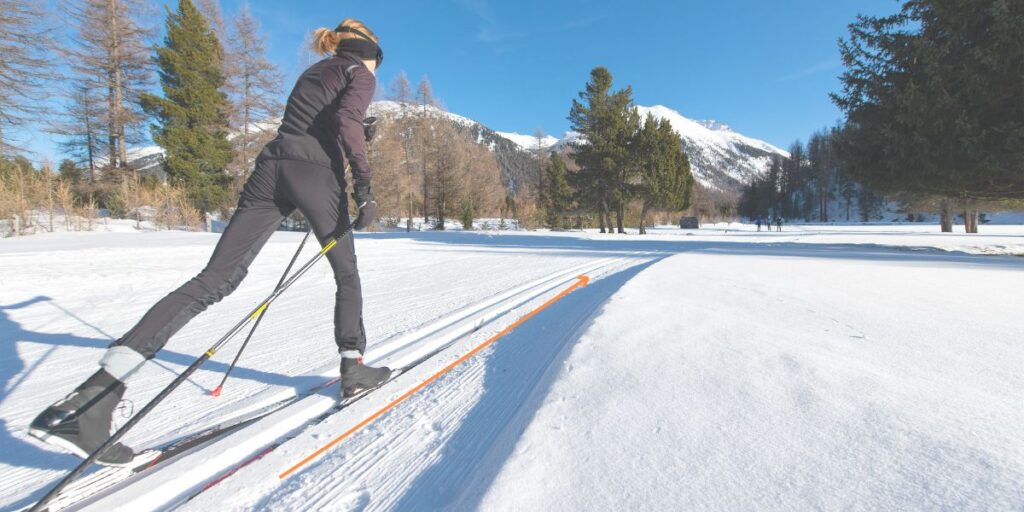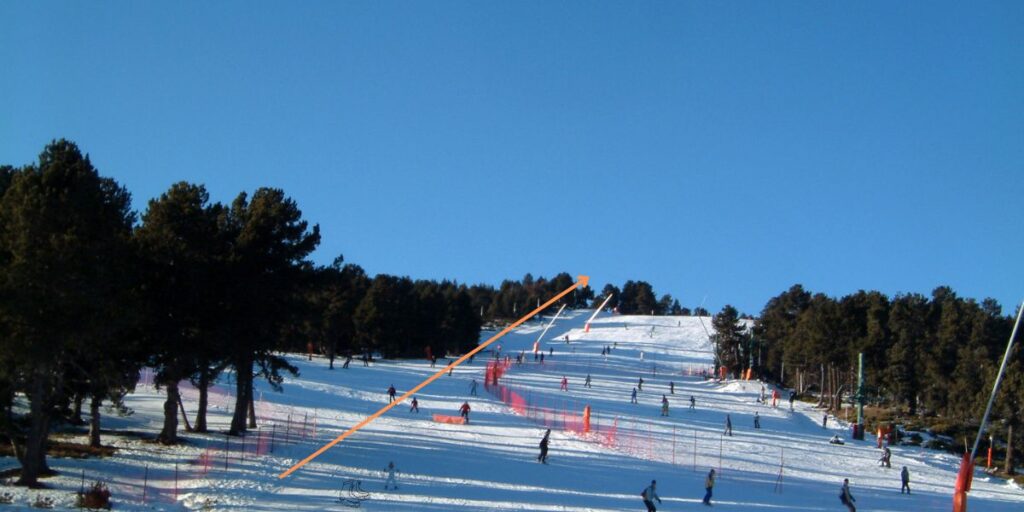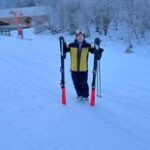Skiing is an exhilarating sport that combines the thrill of speed with the beauty of winter landscapes. For beginners, learning how to ski can seem daunting. Still, it can become fun and rewarding with proper guidance and practice. In this guide, we’ll take you through the basic skiing steps, from understanding your stance to making your first turns and stopping safely. As someone who loves skiing, I know firsthand the joy and excitement it brings, and I’m here to help you start your skiing journey smoothly.
Understanding the Basics
The Stance

The foundation of skiing is your stance. Your stance affects your balance, control, and ability to turn and stop.
Athletic Stance: Stand with your feet shoulder-width apart. Your knees should be slightly bent, and your weight should be evenly distributed over both feet. Your back should be straight but relaxed, and your arms should be in front of you, slightly bent at the elbows.
Balancing on Skis
Balance is crucial in skiing. You need to be able to adjust your balance as you move and encounter different terrains.
- Stand tall: Imagine a string pulling you up from the top of your head. This will help you stand straight.
- Feel the Middle: Keep most of your weight in the middle of your skis. If you lean too far forward or backward, you might lose balance.
- Practice Shifting: Gently shift your weight from one foot to another while standing still. This helps you get used to how it feels to balance on skis.
Getting Started
Essential Gear for Beginners
Selecting the right gear is crucial for comfort and safety, so start by choosing shorter skis, which are easier to control and more beginner-friendly. Pair these with poles that are appropriate for your height. Ensure your ski boots fit snugly to provide better control and avoid discomfort. For clothing, opt for moisture-wicking base layers, insulating mid-layers, and waterproof outer layers to keep you warm and dry. Remember to wear a helmet for protection, goggles to shield your eyes, gloves to keep your hands warm, and hand warmers for extra comfort.
Physical Conditioning
Getting in shape helps you enjoy skiing more and reduces the risk of injury. Focus on exercises that strengthen your legs and core, such as squats and lunges. Running or brisk walking can also improve your endurance.
If this is your first ski trip, don’t worry too much about an intense workout routine. Just stay active and fit with some basic exercises. Starting with squats and lunges is a great way to prepare your body without overdoing it.
Learning on the Slopes
Walking with Skis

Before going down a slope, it’s important to practice walking with your skis on flat terrain. Start by lifting one ski and stepping forward, then bring the other ski forward, mimicking a walking motion with a sliding effect. It will help you get used to the sensation of moving on skis. Once you’re comfortable, practice gliding by pushing off with one foot and sliding on the other ski. This practice will help you get a feel for the balance and motion required for skiing.
Learning to Slide
Sliding on skis is the fundamental movement in skiing. Begin on a gentle slope to practice this essential skill. Start by finding a slight, gentle slope, avoiding steep slopes at this stage. Stand at the top of the hill in your athletic stance, with your feet shoulder-width apart and knees slightly bent. Keep your back straight but relaxed, and position your arms in front of you with a slight bend at the elbows. Ensure your skis are parallel and shoulder-width apart, and keep your weight centred over your skis, not leaning too far forward or backwards.
To start sliding:
- Use your poles to push off gently and begin sliding down the slope.
- Focus on maintaining your balance by keeping your knees bent and weight-centred.
- Look straight ahead, not down at your skis, to help maintain your balance. If you feel you’re going too fast, apply gentle pressure to the inside edges of your skis to slow down.
- Keep practising this motion until you can comfortably control your speed.
Once you’re confident sliding with poles, try sliding without them. Push off with one foot and glide down the slope, relying on your balance and stance. It will help you develop essential skills for skiing on more challenging slopes.
Turning Techniques
The Wedge Turn
The wedge turn, also called the snowplough turn, is a fundamental technique for beginners. To form a wedge, point your skis inward, creating a V shape with your heels apart. This position helps control speed and direction. To initiate a turn, shift more weight onto your right ski to turn left and onto your left ski to turn right. Use your knees and hips to control the turn by pressing down with the inside edge of your outside ski.
Parallel Turns
After mastering the wedge turn, you can progress to parallel turns, which offer better control and efficiency. Start in a wedge position and gradually bring your skis parallel as you begin the turn. Shift your weight to the outside ski and guide the turn with your knees and hips. Parallel turns align your skis, making your movements more fluid and precise.
Advanced Turning Techniques
Note: The following techniques are advanced and should be attempted only after mastering basic turns.
Carve Turns
Carve turns are advanced techniques for those who want to enhance their skiing skills. To perform a carved turn, shift your weight onto the edges of your skis. This action bends the ski into an arc, enabling a seamless turning motion. Start by positioning your feet hip-width apart and leaning forward to gain momentum. Roll your ankles to the side to start the turn, moving your knees and ankles from side to side to change direction. Apply more pressure to the ski edges to slow down and complete the turn.
Must read What is carving skiing. How to carve on skis.
Short-Radius Turns
Short-radius or slalom turns are quick, short turns that help navigate tight spaces. Keep your skis parallel and execute a short-radius turn with swift, powerful movements. Lean forward slightly and push with both legs to make rapid turns. This technique requires good balance and quick reflexes, making it ideal for more advanced skiers.
Stem Christie Turns
Stem Christie turns are intermediate techniques that bridge the gap between wedge and parallel turns. Start in a wedge position and begin the turn by shifting your weight to the outside ski. As you progress through the turn, bring your skis parallel. This technique helps develop the skills needed for parallel skiing while providing more control and stability.
Stopping Techniques
The wedge stop is a fundamental stopping technique for beginners learning to control speed and stop safely. To execute a wedge stop, point the tips of your skis towards each other, forming a V shape. This position is also known as the snowplough. Apply outward pressure with your heels, engaging the inside edges of your skis. As you increase this pressure, you will gradually slow down and come to a complete stop. This method is practical and easy to learn, making it ideal for beginners. For tips on improving your stopping technique and sidestepping common pitfalls, check out our comprehensive guide on how to stop on skis.
Skiing on Green Runs

Green runs are beginner-friendly slopes, perfect for building foundational skiing skills. These gentle slopes allow new skiers to practice their stance, which involves slightly bent knees, evenly distributed weight, and adequately positioned arms for balance. Start with small gliding motions to get used to the feel of skiing.
On green runs, you can easily control your speed and direction. Practice the wedge or snowplough position by pointing the tips of your skis towards each other to form a V shape. It helps you slow down and stop gradually as you gain confidence. Practice turning by shifting your weight from one ski to another using the wedge turn technique.
Consistent practice on green runs is essential for building confidence and improving skills. Focus on maintaining your stance, controlling speed, and turning smoothly. Repetition helps develop muscle memory, making you more comfortable on the slopes. As you progress, attempt longer runs or slightly steeper sections of the green run.
Safety and Practice
Safety is paramount on the slopes. Skiing safety requires constant awareness of your surroundings and skiing within your abilities. Always follow slope signs and markers to stay informed about conditions and potential hazards. Maintaining control is crucial; always be able to stop or avoid obstacles to ensure your safety and the safety of others. Additionally, respect other skiers by giving the right of way to those below you and avoiding sudden movements that could cut off fellow skiers.
Consistent practice is essential for improving your skiing skills. Repetition of each technique helps build muscle memory, making movements more intuitive. Lessons from a professional instructor can provide valuable feedback and guidance tailored to your skill level. Practising on different slopes and terrains also helps develop versatility, preparing you for various skiing conditions.
Overcoming Common Challenges.
Fear of Falling
Falling is a natural part of learning to ski. Understanding how to fall safely can help alleviate fear.
- Controlled Falls: If you feel like losing control, try to fall to the side rather than backwards or forwards.
- Get Up Safely: To get up, roll onto your side and use your poles to push yourself up.
Fatigue
Skiing can be physically demanding. Building endurance and strength will help you ski longer and more comfortably.
- Conditioning: Engage in regular physical conditioning, focusing on leg strength, core stability, and cardiovascular fitness.
- Rest: Take regular breaks to avoid overexertion and fatigue.
Conclusion
Skiing is a rewarding sport that offers both physical and mental benefits. By following this guide and practising regularly, you can develop the skills and confidence to enjoy the slopes safely and effectively. Remember to start with the basics, practice consistently, and gradually progress to more advanced techniques. From my experience, the key to learning to ski naturally is to embrace the process, be patient, and have fun. With dedication and practice, you’ll be gliding down the slopes with confidence and ease.

